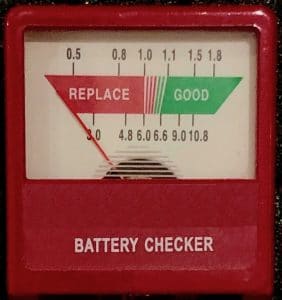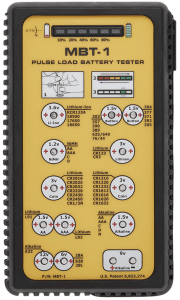
Power to the people
Batteries are a major part of our lives. Even the most mundane devices often require batteries of some kind. So we use battery testers to measure them.
In the past I’ve used rechargeable batteries instead of regular AA or AAA aka lines, but in the last few years I’ve found it easier just to purchase replacements than fiddling with an external charger.
All batteries are not equal
Just because the battery size is standardized, there is still a lot of variation.
Even the common non-rechargeable AA battery might be carbon-zinc, alkaline, or lithium chemistry with very different characteristics.
The inexpensive carbon-zinc battery that works fine in a flashlight or remote control is a bad choice for a handheld game or CD player.
The pricey lithium with it’s long life is ideal for a smoke detector, but probably not a cost-effective choice for a portable digital music player.
Charge me up
Rechargeable batteries also vary in price and performance. Older nickel-cadmium batteries suffer from memory effect and will stop keeping a full charge if you recharge them before they are completely drained.
Newer lithium-ion or lithium-polymer batteries don’t have that problem, but they can be fire hazards if punctured and damaged by heat.
Did you know that most rechargeable batteries have a voltage of 1.2 volts while regular batteries of the same size/shape are 1.5 volts?
That may not see like much, but some devices are sensitive to the difference. When the user manual says “do not replace standard batteries with rechargeable batteries” you probably shouldn’t ignore it.
Measuring electrical flow
The important attributes of a battery are the voltage and amperage. The best analogy is to think of electricity flowing like water in a pipe.
Voltage is the pressure and measures how fast the electricity is flowing out.
Amperage is a measure of the volume of electricity that is flowing.
If you have a small garden hose under high pressure, a lot of water is flowing through the hose and can fill up a bucket pretty quick.
If you have a large pipe but only a trickle of water coming through, it might take much longer to fill up that same bucket.
Electrical power is the total amount of electricity (energy) used and is a combination of voltage and amperage.
Think of watts as a measure of the capacity of that pail. You can fill the pail slowly or quickly with high pressure or low pressure and with a large hose or small hose, but eventually the pail will be full.
Some electrical circuits need a nearly constant flow of electricity (steady voltage) while other circuits need a high volume of electricity (amperage).
The total output of a battery in watts is less important than how the power is delivered – volts and amperage. The wrong volts or amps and the device won’t work, even if there is energy still remaining in the battery.
You gotta know when to throw them
With apologies to Kenny Rogers, the hardest thing about batteries is figuring out when to replace them.
The power from a battery decreases in a non-linear fashion. That means they don’t wear out in a predictable way.
Some types of batteries have a slow, gradual decline in voltage as they are used. Other types might have constant voltage until they are suddenly out of power completely.
Most battery testers aren’t that good
The most common way to test a battery is to measure it’s voltage. You can use specialized, inexpensive battery testers with a mechanical needle and a “good” or “bad” indicator.
These are so simple that battery manufacturers have figured out how to build basic battery testers right into the throw-away plastic packaging the batteries come in.
The digital multimeter (DMM) is a handheld device that can measure electrical properties like voltage, amperage, current, resistance, continuity and more. You can use a DMM to test batteries, but it is no better than inexpensive battery testers.
I recently learned that all these battery testers are garbage.
They test the battery in isolation but not when the battery is working (“under load”). The readings are misleading.
Think about your own heart rate. If you measure yourself when you are sitting down relaxing, you’re going to get a very different number then if you measure yourself while in the middle of running a 10K race.
Pulse load battery testers
Turns out, there are a few battery testers that can provide better results.
Using a technique called pulse load testing, these meters test the battery under a dummy load so they provide a much more realistic measurement of remaining battery capacity.
I have added this as an essential part of my work from home kit.

You may not rush out and buy a pulse load battery tester now, but I found it extremely useful to know they are available.
